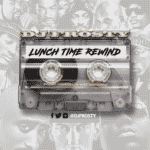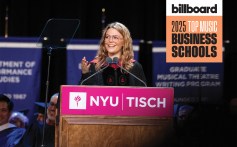Business
Page: 23
Trending on Billboard
Bella Figura Music, a London-based catalog firm with rights to classic hits like Joan Jett’s “I Love Rock ‘n’ Roll,” The Human League’s “Don’t You Want Me” and Hot Chocolate’s “You Sexy Thing,” is making a push into the U.S. market, hiring former Capitol Records exec Gary Gersh and opening an L.A. office.
Founded in 2022 by former BMG U.K. President Alexi Cory-Smith and Neelesh Prabhu, Bella Figura has accumulated a catalog worth more than $160 million — a nearly 50% increase in its portfolio value this year, the firm says. With backing from Freshstream Investment Partners and the Canadian pension fund OPTrust, Cory-Smith says the firm’s expansion plans include deploying another roughly $100 million in the coming year.
Related
To help guide those investments, establish the firm’s reputation in the U.S. and grow the value of its portfolio—which Cory-Smith likens to a Ferrari garage—Bella Figura hired Gersh as chairman and inked a global administration deal with Sony Music Publishing.
“I’ve always used the Ferrari analogy,” Cory-Smith tells Billboard. “They get their hands dirty … constantly going back to fix it and get it better. It’s got to be a champion. Our thing is, is it good? It’s got to be great. The high value, slightly low margin game—that’s not us at all.”
Among the company’s largest acquisitions were the 2024 acquisition of iconic British publisher RAK, which brought in roughly 1,500 copyrights, and the British independent label Jeepster Records, which has the rights to several Belle and Sebastian and Snow Patrol albums. Bella Figura also owns the publishing catalog of songwriter and Robbie Williams collaborator Guy Chambers’, including rights to “Angels,” Feel” and “Let Me Entertain You,” and the master recordings to David Gray’s “Babylon,” because of its acquisition of his IHT record label.
Known for signing Nirvana and Sonic Youth and later running the global live entertainment company of AEG’s touring division, Gersh will be a key adviser in Bella Figura’s U.S. expansion, which he described as careful and precise.
“We’re offering attention to detail, focus, real partnership and opportunity,” Gersh says. “We are picking partners that understand that by doing less better we stay essential. We stay focused.”
Gary Gersh
Bella Figura
Cory-Smith says roughly three-quarters of the firm’s portfolio are publishing copyrights, a “scalable” asset they can maximize returns from by cleaning up metadata and ensuring more efficient registration of songs, using third party tools from Curve and Orpheum. Successful new creative projects have included landing “You Sexy Thing” in a Verizon commercial for the iPhone 17 pro that featured Kevin Hart and plans for special 30th anniversary records for Belle and Sebastian’s If You’re Feeling Sinister.
Cory-Smith and Gersh say their worldwide administration deal with Sony Music Publishing (SMP) opens the door to SMP’s global network, including its industry-leading film, TV and video game sync and licensing resources.
SMP President and Co-managing Director Tim Major said by email that Sony’s global reach makes it a “worthy guardian” for Bella Figura’s works.
“Bella Figura represents iconic and evergreen songs from some of the greatest songwriters we have known–songs that people love and will continue to love for generations to come,” Major said. “[We] are excited to work together … to create new and exciting opportunities and strategies for these songs around the world.”
Trending on Billboard
Drake’s music has received “billions of fraudulent streams” on Spotify, according to a new class action lawsuit that says the streaming giant turned a “blind eye” to bots and thus deprived fair pay to thousands of other artists.
In a case filed Sunday in Los Angeles federal court, attorneys for a rapper named RBX (Eric Dwayne Collins) say Spotify is “all too happy” to ignore billions of fake streams per month that falsely inflate some artist stats – and that Champagne Papi was one of the most-boosted artists.
“Billions of fraudulent streams have been generated with respect to songs of ‘the most streamed artist of all time,’ Aubrey Drake Graham, professionally known as Drake,” the rapper’s lawyers write. “But while the streaming fraud with respect to Drake’s songs may be one example, it does not stand alone.”
Related
The lawsuit claims that Spotify’s policies against fake streams are “nothing more than window dressing” and that the company would prefer to do nothing because bots help the company’s bottom line.
“The more users (including fake users) Spotify has, the more advertisements it can sell, the more profits the company can report, all of which serves to increase the purported value delivered to shareholders,” RBX’s attorneys say.
And such “cheating” has real victims, the lawsuit says: “This mass-scale fraudulent streaming causes massive financial harm to legitimate artists, songwriters, producers and other rightsholders whose proportional share is decreased as a result of fraudulent stream inflation on Spotify’s platform.”
A spokesman for Spotify did not immediately return a request for comment. Drake was not named as a defendant in the lawsuit nor accused of any wrongdoing; a rep for the star did not return a request for comment.
Streaming fraud on platforms like Spotify, Apple Music and Amazon Music is a longstanding problem, made all the more challenging in recent years by advances in artificial intelligence and other sophisticated spoofing technologies. By some estimates, several percentage points of all streams are inauthentic – meaning billions of monthly plays. Since royalties on digital services are divvied up among rightsholders from a finite pie, such phony numbers siphon off revenue from legitimate streams.
Related
In one extreme example, a North Carolina man was indicted last year on federal charges that he used AI to help create “hundreds of thousands” of songs and used thousands of bots to stream them millions of times. The feds say the scheme diverted over $1 million per year from real artists.
In his lawsuit on Sunday, RBX says he wants to force Spotify to take more aggressive action against such behavior on its platform, calling its current anti-fraud policies “inadequate at best.”
“Plaintiff brings this case to bring justice for his brother and sister creators and entertainers,” his lawyers write. “In doing so, Plaintiff gives a voice to more than one hundred thousand rightsholders who, among other things, may be unable or too afraid to challenge Spotify, a powerful force in the music business whose failure to act has caused significant problems and great financial harm.”
In technical terms, the lawsuit accuses Spotify of legal negligence, meaning the company caused harm to him and others by failing to take steps it should have taken. He also claims the company violated California state law against unfair competition.
The case is filed as a proposed class action, meaning RBX wants to represent thousands of other artists who have allegedly faced the same harm he did. But such other artists will only be drawn into the case if a judge grants approval – a difficult threshold to clear in any class action litigation.
Trending on Billboard
Belmont University’s new Center for Mental Health in Entertainment, launched by the University’s Mike Curb College of Entertainment & Music Business and the College of Pharmacy & Health Sciences, has tapped industry veteran and licensed clinical social worker Debbie Carroll as its executive director.
Carroll was most recently vp of entertainment and specialized services at Onsite Entertainment and previously spent more than 20 years as vp of health and human services at MusiCares.
Related
Carroll will also hold the position of CMA endowed chair as part of a $3 million gift from the Country Music Association to the new center. Two million dollars of that will go towards the creation of the chair and the executive director position, while the remaining $1 million will go toward programming. The $2 million will be matched by the Johnson Academic Challenge at Belmont, for a total of $5 million.
“I’m honored to step into this role and help lead a transformative initiative that places mental health at the heart of the entertainment industry,” said Carroll in a statement. “This Center represents a powerful opportunity to build a culture of care, resilience and innovation for artists and professionals across music, film, television and beyond. With Belmont’s deep commitment, and CMA’s visionary support, we’re poised to make a lasting impact, starting in Nashville and reaching far beyond.”
Belmont University Center for Mental Health in Entertainment
Courtesy
The Center will address the critical need for mental health research, education and resources in the entertainment industry. It will serve both students and industry professionals.
CMA CEO Sarah Trahern added, “As a trade association, it’s our responsibility to care for the people who make this industry thrive. Supporting their well-being has always been central to CMA’s mission, and through years of investments and partnerships, we’ve seen how access to care can change lives. This collaboration with Belmont allows us to take that support a step further—transforming advocacy into meaningful, long-term change. With a leader like Debbie Carroll guiding this work, we’re helping ensure a stronger, healthier music community for generations to come.”
Brittany Schaffer, dean of Curb College, said, “Our partners, like CMA, know a thriving entertainment industry begins with healthy, supported individuals connected by community. This center will invest in today’s leaders and creators, prepare the next generation to confidently navigate challenges, and serve as a model for how our industry can care for its own. Debbie Carroll has long been the trusted voice on mental health in entertainment—her wisdom, compassion and proven leadership have shaped the vision for this Center from the spark of the idea, and I have every confidence in her as our inaugural CMA Endowed Chair & Executive Director. With Debbie at the helm, we have the opportunity to forever change culture.”
Trending on Billboard
Spotify has unveiled its most extensive out-of-home (OOH) and on-platform campaign to date in support of the 2025 ARIA Awards, spotlighting nominated Australian talent across more than 800 high-impact placements around the world — from major Australian cities to international landmarks including Times Square in New York and Leicester Square in London.
The campaign, launched in partnership with the ARIA Awards, aims to engage fans both locally and globally by integrating public voting directly into Spotify’s platform.
Related
Voting-enabled playlists are embedded within the app across four major categories: Best Australian Live Act, Song of the Year, Best Video and Most Popular International Artist. Fans are directed to the ARIA Awards hub via homepage banners, curated nominee spotlights, and QR codes displayed on select billboards.
According to Spotify, more than 250,000 Australians have already cast their votes through the platform, with engagement surpassing the past two years combined. Billboard placements across the U.S., U.K., and other key territories will continue to promote nominees in the lead-up to the ceremony, while winners will be celebrated globally after the ARIA Awards air on Nov. 19.
“The ARIA Awards 2025 campaign is Spotify’s most extensive local on-platform promotion ever — from in-app voting to high-impact OOH celebrations,” said Rosie Rothery, head of marketing at Spotify ANZ. “We’ve flexed the power of our platform and global footprint to put Australian artists and their success stories front and center.”
In addition to digital integrations, Spotify’s campaign includes a social media rollout, an ARIA Awards Spotify Artist Party, and the “Best of the ARIAs” collection — a curated shelf highlighting iconic Australian albums and past winners.
Annabelle Herd, CEO of ARIA, added: “The ARIA Awards 2025 are shaping up to be the biggest global platform to date for the incredible Australian artists making waves in culture around the world. As part of the ARIA Awards’ partnership with Spotify, we are thrilled to bring this year’s nominees to the streets that countless Australians travel day-in, day-out… before lighting up some of the world’s most iconic locations. This is what Aus music looks like on the world’s stage!”
The campaign continues Spotify’s 13-year commitment to promoting local music and complements its broader “Turn Up Aus” initiative focused on uplifting Australian artists.
Trending on Billboard
Sony Music announced Saturday (Nov. 2) that Vanessa Picken is stepping down as chair and CEO of Sony Music Australia and New Zealand, ending a three-year tenure marked by structural modernization, artist-first initiatives and industry-first milestones.
“It has been a privilege to lead such a dedicated and talented company, collaborating with so many inspiring artists and their teams,” Picken said in a statement. “Supporting their growth, creativity, and bold visions has been one of the most rewarding aspects of my role. With my term now complete, I feel this is the perfect time to embrace my next opportunity.”
Related
Picken was appointed in June 2022, becoming the first woman to lead the major label’s operations across both countries. She officially began in September 2022, succeeding former CEO Denis Handlin, who exited in 2021 following an external investigation into workplace culture. Her appointment was widely seen as a reset moment for the company.
Over the past three years, Picken spearheaded efforts to modernize the company’s internal operations and improve artist relations. Under her leadership, Sony Music ANZ invested in digital innovation, experiential brand opportunities and new licensing models, while placing increased emphasis on artist well-being and transparency.
“I am incredibly proud of what we have achieved together over the past three years, particularly during this transformative period for our Australia and New Zealand operations,” Picken continued. “We’ve modernized our organizational structure, enhanced our digital and marketing capabilities, and fueled new growth through experiential and licensing ventures. Throughout it all, we’ve placed a renewed focus on artist wellbeing and deepened their connection to the team.”
“As I move on from being the first woman to hold this role, I do so with great excitement for the future,” she added. “I’m confident I won’t be the last, and I hope that in the process, I’ve inspired others to follow their own paths.”
Rob Stringer, chairman of Sony Music Group, thanked Picken for her contributions in a statement to Billboard: “We extend our thanks to Vanessa for her time at Sony Music and for her commitment to guiding our artists’ careers and championing local creative talent. We wish her every success in the next chapter of her journey.”
No successor has been named, and Sony Music has not announced who will lead the company in the interim.
Trending on Billboard
HYBE shares soared 18.4% in the week ended Oct. 31 after a South Korean court ruled that K-pop group NewJeans may not leave HYBE imprint ADOR and make music under a different name. The five members of the girl group had attempted to break away from HYBE after the K-pop giant dismissed NewJeans’ mentor, ADOR CEO Min Hee-jin, in April 2024.
Rather than lose NewJeans — which would have created additional headaches for HYBE and other K-pop companies — ADOR will retain the group through the end of its exclusive contract in 2029. The fact that Min is no longer at ADOR didn’t sway the court. “Merely the fact that NewJeans personally places high trust in Min Hee-jin does not make guaranteeing her the position of ADOR’s CEO a significant obligation under the exclusive contract,” according to a report. The ruling added approximately $1.5 billion to HYBE’s market value, suggesting that investors were fearful a court loss would spill over to other acts currently under contract with HYBE.
Related
Despite HYBE’s considerable gain, the 19-company Billboard Global Music Index was unchanged at 2,845.53. Music stocks were almost evenly mixed between winners and losers, and only two companies had either a gain or a loss in excess of 10%.
Music stocks lagged behind major indexes’ gains. In the U.S., the Nasdaq composite index rose 2.2% to 23,724.96 and the S&P 500 improved 0.7% to 6,840.20. The U.K.’s FTSE 100 rose 0.7% to 9,717.25. South Korea’s KOSPI composite index jumped 4.2% to 4,107.50 on AI optimism after Samsung announced it would build a semiconductor factory in partnership with American company Nvidia. China’s Shanghai Composite Index ticked upward 0.1% to 3,954.79.
SiriusXM shares finished the week up 1.4% to $21.69 after a see-saw end to the week. The stock gained 10.1% on Thursday (Oct. 30) after the company’s third-quarter results, but fell 6.5% on Friday (Oct. 31). The bump in share price came after SiriusXM increased its full-year forecasts for revenue, EBITDA and free cash flow. The Q3 results also showed that the satellite radio company, which also owns streaming platform Pandora, turned a net loss into a net profit.
Related
Universal Music Group shares fell 2.3% to 23.27 euros ($26.99) despite gaining 1% on Friday after the company reported solid Q3 earnings following the close of trading on Thursday. Following the results, J.P. Morgan reiterated its “overweight” rating and 39.00 euros ($45.23) price target while Guggenheim maintained its “neutral” rating and eliminated its price target, which was previously 27.00 euros ($31.32).
Spotify’s stock benefited from news that the company is raising prices in the U.K., finishing the week up 1.5% to $655.32. That modest gain helped Spotify reclaim some of the loss it suffered after the share price dropped 4.1% on Oct. 24. The Stockholm-based company will report Q3 earnings on Tuesday (Nov. 4).
Radio giant iHeartMedia was the week’s biggest loser after dropping 12.4% to $2.97. The company’s share price has been on a roll lately, though, gaining 39.4% in 2025. iHeartMedia will release Q3 earnings on Nov. 10.
Most live music stocks lost ground. Live Nation fell 2.2% to $149.53 ahead of its earnings results on Tuesday. German promoter CTS Eventim dropped 2.9% to 77.60 euros ($90.00). MSG Entertainment dipped 3.5% to $44.16. Sphere Entertainment Co. was an exception, rising 1.7% to $68.48.
Billboard
Billboard
Billboard
Trending on Billboard
Rufus Wainwright is the latest singer to change the lyrics of “O Canada.”
At Wednesday’s (Oct. 29) Game 5 of the World Series between the Toronto Blue Jays and the Los Angeles Dodgers, the Montreal-raised singer-songwriter performed a bilingual version of the Canadian national anthem at Dodger Stadium.
Related
Instead of the anthem’s usual line, “true patriot love in all of us command,” Wainwright sang: “true patriot love that only us command.”
The change has been interpreted as a protest of U.S. President Donald Trump, who has made threats of annexation of Canada as the “51st state.”
It’s the same lyrical change that fellow Canadian singer Chantal Kreviazuk made during the height of tariff tension in February, while performing at the final 4 Nations Face-Off hockey game in Boston, Massachusetts.
Kreviazuk subsequently shared a now-deleted Instagram post, confirming that the lyric change was intentional and that she wrote the words on her hand to remember them.
“I truly believe that we must stand up, use our voices and try to protect ourselves,” she wrote at the time. “We should express our outrage in the face of any abuses of power. I was raised in part by music that was inspired by brave voices committed to peaceful conflict resolution.”
This isn’t the first time a Canadian artist has taken a jab at Trump’s comments. Country singer Dallas Smith is currently on a 51-date cross-country tour, an intentional nod to the 51st state comments, making intimate stops all across Canada.
Two days before Wainwright’s performance, Toronto-born, Los Angeles-based singer JP Saxe performed the Canadian national anthem at Dodger Stadium during Game 3. He swapped out the “Our home and native land” line for “Our home on native land.”
Saxe went viral on social media in August for starting an important conversation about touring as an artist, after cancelling his tour due to low ticket sales.
He followed in the footsteps of acclaimed singer-songwriter Jully Black, who made the one-word lyric change in 2023, while performing “O Canada” at the NBA All-Star Game. Black went on to be honoured by the Assembly of First Nations.
Wainwright and Saxe join the growing list of Canadian artists who have performed the national anthem at this year’s World Series, including Alessia Cara (Game 2) and Deborah Cox (Game 4).
Following yesterday’s 6-1 win, the Jays are one game away from winning the World Series, which returns to Toronto for Game 6 tomorrow night (October 31) and Game 7 (if necessary) on Saturday (Nov. 1).
Read more here. — HTS
Toronto’s Budweiser Stage to Become RBC Amphitheatre
Say hello to RBC Amphitheatre.
Live Nation Canada and RBC have announced a multi-year partnership to expand the Toronto waterfront venue — starting with the replacement of its former name, Budweiser Stage, effective immediately.
RBC Amphitheatre is set to be transformed and expanded into a year-round venue by 2030.
Related
The concert venue, on the site of the old Ontario Place Forum, opened in the mid-1990s under its initial name, Molson Amphitheatre, and was renamed Budweiser Stage in 2017. Its new name is a callback to its origins.
“It is a nod to the past, but it’s also forward looking,” says Wayne Zronik, president of business operations at Live Nation Canada, in an interview with Billboard Canada. “We’ve all been down there for shows. It’s been around for 30 years, and it’s one of the best in the world. It’s so amazing and so to preserve that, yet to also have it be available in this very unique year-round configuration for generations to come is very exciting for us.”
Embarking on renovations, the event space will expand its indoor and outdoor capabilities. By becoming a full-year venue, RBC Amphitheatre will include an expanded capacity in the summer and approximately 9,000 seats in the winter, featuring seated and an open-air lawn section from May to October.
Zronik says the winterization will include an “operable panel system” that will enclose the pavilion in a temperature-controlled environment starting in the fall months.
The event space is expected to close for renovations in fall 2027 and reopen in spring 2029, with full-year capabilities complete by summer 2030.
Inspired by fan feedback, the venue will feature a pedestrian bridge that improves access and eases crowd flow. Live Nation also promises upgraded amenities like expanded food and beverage options, hospitality areas and a new lookout deck with elevator access to the lawn. The city skyline views will remain central to the venue’s identity.
With the proposed changes and transformation, RBC Amphitheatre is set to significantly increase its show count, hosting over 1.5 million fans annually.
Venue upgrades will include multiple tiers of VIP experiences (as is the current trend with venues), as well as infrastructure to support modernized concert production and backstage amenities for some of the biggest artists in the world. Toronto has become one of the biggest global touring markets, which has inspired Live Nation’s expanded presence in venues, including the new Rogers Stadium that opened this summer.
“I think we have to continue to invest in cultural infrastructure so that we can accommodate these shows,” says Zronik. “The Amphitheatre is 30 years old; by the time this is done, it would have been 35. You have to revitalize these things.”
Building signage of the previous venue name will remain visible as the space transforms in the months leading up to the 2026 season, when the RBC Amphitheatre name will replace it. The venue currently has four shows announced for next year’s lineup, including Canadian rapper bbno$, American musician MGK, country star Bailey Zimmerman and Australian boy band 5 Seconds of Summer.
Read more here. — Heather Taylor-Singh, Richard Trapunski
Independent Music Industry Groups Ask for Public’s Help to Renew Canadian Music Funding
Independent music organizations are asking the public for help as the deadline looms for Canadian music funding.
A $16 million annual boost was announced in 2024 as a temporary top-up to the Canada Music Fund — which supports both FACTOR and Musicaction, two of the country’s biggest and most important music grants.
Related
The update promised $32 million over two years to enhance the careers of Canadian artists, while strengthening the competitiveness and stability of the Canadian music sector.
With the deadline for the funds approval looming by March 31, 2026, independent groups including the Canadian Independent Music Association (CIMA), SaskMusic, Music NL and more have requested the public’s assistance in reaching out to local MPs to ensure the funds are renewed.
If not, they warn, the investment, which impacts Canadian-owned music companies and artists, could be slashed by up to 50%.
Earlier this month, the federal government announced that the 2026 budget will be discussed on Nov. 4 — months earlier than its initial March deadline.
The news comes at a pivotal time for the Canadian music industry.
According to CIMA, contributions from private radio broadcasting to FACTOR have significantly decreased from $16 million in the early 2020s to approximately $2 million this year. In 2024, the funding body was the victim of a $9.8 million cybertheft.
Meanwhile, funds from Bill C-11 (Online Streaming Act), a part of which was intended to allot 5% of revenue from major foreign-owned digital streaming platforms, have been paused after major streamers like Spotify, Amazon and Apple took the government to court.
“Whether you are a large Canadian company, a new music start up, an established artist or fledgling musician, everyone in our sector benefits from the investments made by FACTOR and Musicaction,” shares Andrew Cash, CIMA president and CEO, in a statement.
Cash urges the public to contribute by emailing Stephen Guilbeault, Minister of Canadian Identity and Culture, François-Philippe Champagne, the Minister of Finance and Prime Minister Mark Carney.
“Now more than ever before we need to be strengthening the fabric of Canadian-made culture,” he said.
With only a week to go, the organizations are encouraging the public to speak up by emailing representatives.
Read more here. — HTS

Trending on Billboard
Former Hot Boys member Turk is being sued by a concert promoter over online threats that supposedly threatened to derail a Cash Money Records reunion tour this summer.
The $12 million breach of contract and defamation lawsuit, filed in New York federal court on Wednesday (Oct. 29), is the latest in a bitter legal salvo between Turk (Tab Virgil Jr.) and promoter Dope Shows over the Cash Money Millionaires 30th Anniversary Tour. Named in honor of a Cash Money Records supergroup from the ’90s, the ongoing reunion tour features Cash Money figures like Birdman, Juvenile and former Hot Boy B.G.
Related
Turk originally signed onto the tour as well, but was kicked off the roster before his first performance this summer. The rapper subsequently sued Dope Shows for $340,000 in Florida last month, alleging he was removed from the tour because the promoter wasn’t selling enough tickets and ran out of money to pay him.
Now, Dope Shows is countering in its own lawsuit that money had nothing to do with Turk’s removal. Rather, the promoter says it had to boot Turk because he had been physically threatening B.G. on social media — leading venues to voice concerns about potential violence and risking disruptive intervention from B.G.’s probation officer.
Dope Shows alleges that in response, Turk began posting defamatory content on Instagram, spreading his false narrative that the promoter was struggling financially. Dope Shows claims Turk’s Florida case is a “sham lawsuit” that merely serves to amplify those falsehoods.
Related
“Desperate to revive his flagging rap career, Turk is attempting to sabotage the tour through childish and petulant antics that he hopes will regain the public’s attention,” writes Dope Shows’ lawyer, Jeffrey Movit. “Turk’s publicity stunts are an abject failure, as they have done nothing to advance his career. Rather, through his malicious and misguided actions, Turk has created nothing more than massive legal liability for himself in this lawsuit”.
Dope Shows alleges that Turk owes $5 million for breach of contract and $7 million for defamation. According to the lawsuit, Turk’s conduct has deterred fans from attending the reunion tour and led other artists to doubt the promoter’s abilities.
Turk’s attorney, Paul Aloise, denied all of Dope Shows’ claims in a statement to Billboard on Friday (Oct. 31). Aloise says the new lawsuit is a “desperate attempt” by the promoter to “try and shift the blame away from their own unethical business practices and promotional failures.”
“While the complaint defames my client and says that he was attempting to sabotage the tour to try and revive his flagging rap career, the complaint conveniently leaves out the fact that on August 3, 2025, Turk, released his own album, JOSEPH, on iTunes, which peaked at #5 on the iTunes Hip-Hop Chart,” added Aloise. “Thus, my client has no intentions of trying to sabotage a tour he wants to be on, let alone to help his rap career.”
Trending on Billboard Anyone who’s received an email inquiry from promoter and music manager Barrie Marshall might need to double-check that it was really him. Representatives from Marshall Arts sent out a rare press release on Friday (Oct. 31) warning that someone is impersonating the AEG-aligned promoter, who works with stars like Paul McCartney and […]
Trending on Billboard
A few years into the debate about AI’s potential economic impact on music, the jury is still out.
AI could be great for the music business, enabling new products and creating new revenue streams for artists and songwriters. Universal Music Group (UMG) has said as much. “We believe the commercial opportunity is potentially very significant,” chief digital officer Michael Nash said during the company’s earnings call on Thursday (Oct. 30), a day after it announced a licensing deal with AI music generator Udio. “These new products and services could constitute an important source of incremental additional new future revenue for artists and songwriters.”
Related
Then again, AI could erode record labels and music publishers’ businesses by flooding the internet with inexpensively made music that takes some — not all — of their market share. Record labels have already lost market share to independent artists in recent years, and AI could be either a continuation or acceleration of existing trends.
Two years ago, analysts at Barclays Research were dismissive of AI-generated music’s threat to the established music business. The general population might have access to music-making tools, but, Barclays reasoned, the quality of the music was poor, and songs created by faceless software housed on computer servers couldn’t create the human connection that listeners desire. Record labels and music publishers could be hurt if social platforms pushed AI music, but the money-saving tactic could run into legal roadblocks, they said. For all the initial hoopla about AI’s ability to upset the status quo, too many questions at the time remained unanswered.
Today, though, Barclays is singing a different tune, and advancements in AI platforms have answered some of their earlier questions. Now, the analysts are more convinced of AI music’s potential to erode record labels’ market share and weaken their financial standing. The quality of music has “improved significantly,” they wrote in a Tuesday (Oct. 28) report titled “AI in Music: Danger Zone,” adding that it’s “hard to differentiate between human music and AI music.” Fans still crave connections with human artists, they wrote, but as opposed to their earlier take, they conceded that AI music represents a threat to the music establishment.
Related
In the Barclays analysts’ view, AI is a mixed bag of gains (such as AI-enabled superfan tiers) and losses (lower royalties from social media platforms’ adoption of cheap AI music). Overall, though, they believe the damage that AI can create will outweigh its benefits. Their bottom line: In an average scenario, UMG takes a 1% hit to earnings before interest, taxes, depreciation and amortization (EBITDA) and Warner Music Group’s EBITDA drops 4%. A worst-case scenario calls for deeper losses. A best-case scenario sees AI providing a boost.
Not everybody is in the Barclays camp, however. Despite advancements in the quality of music produced by AI platforms, analysts at J.P. Morgan are sticking with their opinion from 2023 that AI will not have “a meaningful impact on industry revenues.” Analysts wrote in a note to UMG investors on Monday (Oct. 27) that AI risks have been “negated” and “controlled” by the company’s efforts in recent years to get streaming platforms to prioritize and reward professional artists over mass-produced, low-quality recordings.
Like Barclays, J.P. Morgan believes market erosion is a genuine threat to UMG’s market share. But J.P. Morgan analysts see much more upside in AI. (Notably, J.P. Morgan’s analysis was less thorough; unlike Barclays, it didn’t put a dollar value on AI’s potential impact.) They note that UMG will benefit from AI artists’ need for publishers and record labels (which jibes with Billboard’s assessment of Hallwood Media’s impact on Xania Monet’s on-demand streams). AI can also generate revenue streams from new licensing opportunities and make listening to music more enjoyable, they write.
Related
The major labels and publishers haven’t signed or created AI artists yet, but if they do, J.P. Morgan believes they will benefit from economics that are superior to their deals with human artists and songwriters. It’s not a stretch: To capture some of the market share that has shifted to independent artists, UMG has invested heavily in artist services by building up Virgin Music Group and attempting to acquire Downtown Music Holdings (the European Commission will announce its decision on the proposed merger in February 2026). If AI artists are to compete in the marketplace, they will need the same services that are available to human artists, such as promotion, distribution, copyright administration and public relations.
One thing is certain: Because AI music is in its infancy, trying to figure out its long-term trajectory is difficult. When the music industry began navigating the shift from physical to digital in the late ‘90s, few people could have guessed that the marketplace of 2025 would be dominated by subscription royalties and that download revenue would be almost nonexistent. When Napster launched in 1999, nearly a decade before the iPhone debuted, imagining the influence of an app like TikTok would have been nearly impossible. Music companies got to this point by enforcing the value of their intellectual property through a few decades of licensing agreements and lawsuits.
In the near term, expect more deals like UMG’s partnership with Udio. Over the long term, expect to be surprised.

 State Champ Radio
State Champ Radio 







